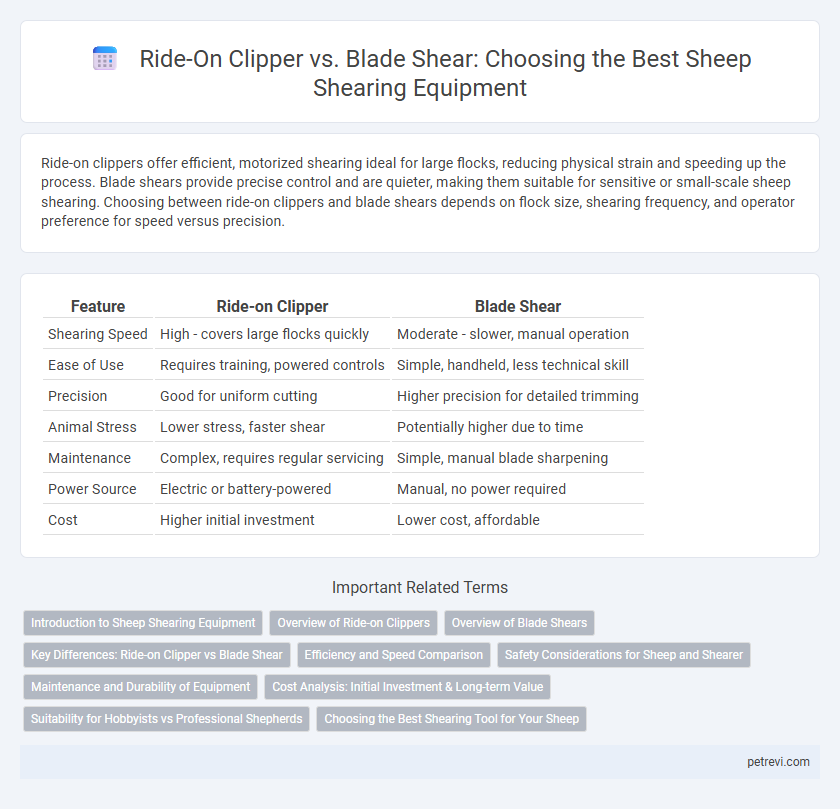Ride-on clippers offer efficient, motorized shearing ideal for large flocks, reducing physical strain and speeding up the process. Blade shears provide precise control and are quieter, making them suitable for sensitive or small-scale sheep shearing. Choosing between ride-on clippers and blade shears depends on flock size, shearing frequency, and operator preference for speed versus precision.
Table of Comparison
| Feature | Ride-on Clipper | Blade Shear |
|---|---|---|
| Shearing Speed | High - covers large flocks quickly | Moderate - slower, manual operation |
| Ease of Use | Requires training, powered controls | Simple, handheld, less technical skill |
| Precision | Good for uniform cutting | Higher precision for detailed trimming |
| Animal Stress | Lower stress, faster shear | Potentially higher due to time |
| Maintenance | Complex, requires regular servicing | Simple, manual blade sharpening |
| Power Source | Electric or battery-powered | Manual, no power required |
| Cost | Higher initial investment | Lower cost, affordable |
Introduction to Sheep Shearing Equipment
Ride-on clippers for sheep shearing provide high power and speed, ideal for large flocks requiring efficient shearing with minimal physical strain on the operator. Blade shears, powered by a reciprocating blade, offer precision and careful handling, suitable for detailed trimming and smaller-scale shearing tasks. Choosing between ride-on clippers and blade shears depends on flock size, shearer skill level, and the desired balance between speed and control in sheep shearing equipment.
Overview of Ride-on Clippers
Ride-on clippers for sheep shearing offer efficient, motorized cutting with adjustable speed settings ideal for handling large flocks quickly. These machines typically feature ergonomic designs that reduce operator fatigue and provide consistent shear quality, improving overall productivity. Compared to blade shears, ride-on clippers deliver faster results and are better suited for commercial sheep shearing operations.
Overview of Blade Shears
Blade shears for sheep shearing offer precise manual control, making them ideal for trimming sensitive areas or handling small flocks. These shears consist of sharp, scissor-like blades that require skill and practice to operate efficiently, providing a quieter, lower-maintenance option compared to electric ride-on clippers. Preferred by some shearers for their portability and ability to produce a clean cut without pulling wool, blade shears remain a traditional tool in sheep shearing equipment.
Key Differences: Ride-on Clipper vs Blade Shear
Ride-on clippers offer high power and speed, ideal for large-scale sheep shearing, while blade shears provide precision and control suited for detailed trimming and smaller flocks. Ride-on clippers use motor-driven rotating blades that reduce shearing time but may cause heat buildup, whereas blade shears rely on manual or motor-assisted reciprocating blades for gentler cuts with less risk of skin injury. Maintenance needs differ, with ride-on clippers requiring regular lubrication and blade sharpening, and blade shears needing frequent blade replacement or sharpening to maintain optimal performance.
Efficiency and Speed Comparison
Ride-on clippers offer higher efficiency and speed for large-scale sheep shearing due to powerful motors and ergonomic design, reducing shearer fatigue. Blade shears provide precision but require more time, making them less suitable for high-volume operations. Choosing ride-on clippers enhances productivity where rapid sheep shearing is essential.
Safety Considerations for Sheep and Shearer
Ride-on clippers provide stable control and reduce fatigue for the shearer, minimizing the risk of accidental cuts to the sheep's skin due to their ergonomic design and consistent blade pressure. Blade shears demand more manual precision and experience, increasing the likelihood of nicks or injuries if not expertly handled, which can stress the sheep and lead to recovery complications. Prioritizing equipment with safety guards, sharp blades, and comfortable grips enhances protection for both sheep and shearers during the shearing process.
Maintenance and Durability of Equipment
Ride-on clippers for sheep shearing require regular blade sharpening and motor cleaning to maintain peak performance, ensuring longer operational life under heavy workloads. Blade shears, being manual, demand less mechanical maintenance but necessitate frequent sharpening and rust prevention to sustain durability. Durable materials like stainless steel blades and robust motor components in ride-on clippers significantly reduce downtime and extend equipment lifespan compared to traditional blade shears.
Cost Analysis: Initial Investment & Long-term Value
Ride-on clippers typically require a higher initial investment, ranging from $1,500 to $3,000, but offer durable performance and faster shearing times, which can reduce labor costs over time. Blade shears are more affordable upfront, with prices between $100 and $300, but may result in longer shearing sessions and more frequent blade replacements, increasing long-term expenses. Evaluating the total cost of ownership, including maintenance, operational efficiency, and labor intensity, helps determine the best equipment choice for sheep shearing operations.
Suitability for Hobbyists vs Professional Shepherds
Ride-on clippers offer high power and efficiency ideal for professional shepherds managing large flocks, providing consistent cutting speed and durability for extended use. Blade shears, being lightweight and easy to handle, suit hobbyists and small-scale sheep owners who prioritize precision and affordability over speed. The choice between ride-on clippers and blade shears ultimately depends on flock size, shearing frequency, and user experience, with professionals favoring ride-on clippers for heavy workloads and hobbyists opting for blade shears for occasional shearing.
Choosing the Best Shearing Tool for Your Sheep
Ride-on clippers provide efficient power and speed, making them ideal for shearers handling large flocks, while blade shears offer precision and gentler handling of delicate wool fibers. Factors such as flock size, wool type, and shearer experience play critical roles in selecting the best shearing tool for sheep. Investing in high-quality, reliable equipment ensures optimal wool quality and animal welfare during the shearing process.
Ride-on Clipper vs Blade Shear for Sheep Shearing Equipment Infographic

 petrevi.com
petrevi.com